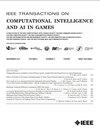The ANGELINA Videogame Design System—Part II
Q2 Computer Science
IEEE Transactions on Computational Intelligence and AI in Games
Pub Date : 2017-06-01
DOI:10.1109/TCIAIG.2016.2520305
引用次数: 40
Abstract
Procedural content generation is generally viewed as a means to an end—a tool employed by designers to overcome technical problems or achieve a particular design goal. When we move from generating single parts of games to automating the entirety of their design, however, we find ourselves facing a far wider and more interesting set of problems than mere generation. When the designer of a game is a piece of software, we face questions about what it means to be a designer, about computational creativity, and about how to assess the growth of these automated game designers and the value of their output. Answering these questions can lead to new ideas in how to generate content procedurally, and produce systems that can further the cutting edge of game design. This paper describes work done to take an automated game designer and advance it towards being a member of a creative community. We outline extensions made to the system to give it more autonomy and creative independence, in order to strengthen claims that the software is acting creatively. We describe and reflect upon the software’s participation in the games community, including entering two game development contests, and show the opportunities and difficulties of such engagement. We consider methods for evaluating automated game designers as creative entities, and underline the need for automated game design to be a major frontier in future games research.安吉莉娜电子游戏设计系统(二
程序性内容生成通常被视为达到目的的一种手段——设计者用来克服技术问题或实现特定设计目标的工具。然而,当我们从生成游戏的单个部分转向自动化整个设计时,我们发现自己面临着一系列比仅仅生成更广泛、更有趣的问题。当游戏的设计师是一个软件时,我们面临的问题是,作为一名设计师意味着什么,计算创造力,以及如何评估这些自动化游戏设计师的成长及其产出的价值。回答这些问题可以带来如何在程序上生成内容的新想法,并产生能够进一步提升游戏设计前沿的系统。本文描述了一位自动化游戏设计师所做的工作,并将其提升为创意社区的一员。我们概述了对系统的扩展,赋予它更多的自主权和创造性独立性,以加强软件创造性行为的说法。我们描述并反思了该软件在游戏社区的参与,包括参加两次游戏开发竞赛,并展示了这种参与的机会和困难。我们考虑了将自动化游戏设计师评估为创造性实体的方法,并强调自动化游戏设计需要成为未来游戏研究的主要前沿。
本文章由计算机程序翻译,如有差异,请以英文原文为准。
求助全文
约1分钟内获得全文
求助全文
来源期刊

IEEE Transactions on Computational Intelligence and AI in Games
COMPUTER SCIENCE, ARTIFICIAL INTELLIGENCE-COMPUTER SCIENCE, SOFTWARE ENGINEERING
CiteScore
4.60
自引率
0.00%
发文量
0
审稿时长
>12 weeks
期刊介绍:
Cessation. The IEEE Transactions on Computational Intelligence and AI in Games (T-CIAIG) publishes archival journal quality original papers in computational intelligence and related areas in artificial intelligence applied to games, including but not limited to videogames, mathematical games, human–computer interactions in games, and games involving physical objects. Emphasis is placed on the use of these methods to improve performance in and understanding of the dynamics of games, as well as gaining insight into the properties of the methods as applied to games. It also includes using games as a platform for building intelligent embedded agents for the real world. Papers connecting games to all areas of computational intelligence and traditional AI are considered.
 求助内容:
求助内容: 应助结果提醒方式:
应助结果提醒方式:


